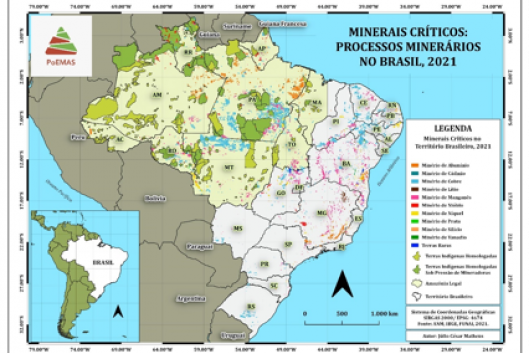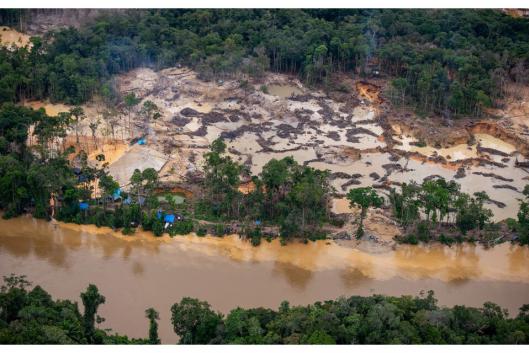The relationship between mining and water should be seen from the perspective of multiple relationships, among which several are capable of generating socio-environmental conflicts. More than that, as Brazil deepens its extractive profile, there is a strong tendency for such conflicts to deepen. Throughout this text, I argue that a conflicting picture in Brazil involving mining and water use already exists, and that the expansion of mineral extraction to obtain so-called critical minerals has a tendency to deepen such conflicts in the near future.
For the discussion of this issue, I have divided the text into two parts. First, I describe the main impacts that mineral activity has on water resources and highlight how they generate socio-environmental conflicts. Then, I present the main vectors of expansion of extraction of critical minerals in the country and analyze the possible social and environmental effects
Mining, water and conflicts
Water plays a central role in mineral extraction activities. It is of such relevance that it can be said that "[in] many mines much more water is extracted than ore". (1) When an assessment is adopted on a global or national scale, the mining sector is usually seen as a small water consumer. For this reason, scale is one of the main aspects to be considered when studying the relationship between mining and water. Rather than looking at averages or national data, it is important to assess the local or, at most, regional scales, since it is at this level that impacts are perceived and, consequently, where conflicts occur.(2)
The extraction and processing of ores require large amounts of water and are chemical-intensive. As a result, the main implications of mining for water dynamics are the depletion of springs or their contamination.
Regarding water consumption, different activities related to mineral extraction are capable of compromising availability for other users. The main ones consist of consumption by the concentration plants (which separate ores from other substances), transportation by pipelines, impact on the dynamics of aquifer recharge due to ore removal, lowering of underground water to access minerals, and damming of rivers to generate electricity, which will supply the concentration plants.
In addition to these impacts, the pollution potential of mining is also of great relevance. In this sense, the effects have a broad scope from the spatial and temporal point of view, and some of the changes may last for decades or even centuries. (3)
In the qualitative aspect, there are several ways in which mineral extraction can negatively impact water resources. A first source of pollutants is the mining front itself, where the material is excavated, since the drainage systems and the discharge process may transfer contaminated effluents to the water bodies. A second problematic activity is mining inside rivers, which uses dredging of the river bed to later separate ores in low concentration (e.g. gold). A third potential source of contamination is leaching, a process whereby material removed from mining fronts is treated with chemicals (e.g. cyanide) that combine with specific ores and facilitate their separation. This process can generate highly polluting effluents. The piles of sterile (4), should also be mentioned, since in some cases, they may contain toxic substances and their deposition on the surface, with the effect of rain, can generate chemical and physical displacement of the material, contaminating the water. Finally, there is still the problem of tailings dams (5), which are commonly built on river beds and, therefore, generate the risk of contamination in case they contain toxic substances (6).
As a consequence of all these impacts, it is not uncommon for mining companies to come into conflict with other users of water resources. In recent years, there has been a significant increase in socio-environmental conflicts involving water and mining. Between 2011 and 2020, in Brazil, the number of these conflicts increased from 11 to 143 per year. Thus, since 2014, when they overtook hydroelectric plants, mining companies have been the main drivers of conflicts over water. (7)
'Critical minerals' and the expansion of the extractive frontier
The Brazilian economy has a strong extractive profile, and there is the expectation of further expansion of mineral extraction in the country in the coming years. The Brazilian Mining Institute (Ibram) foresees, for the period between 2022 and 2026, investments of around US$ 40.4 billion. This amount is the second highest figure in an upward curve of investments that began in the five-year period 2017-2021, when the forecast was US$18 billion.(8)
Part of the planned investments will go, in particular, to the extraction of so-called critical minerals. This term has been used to denote minerals that are used in technology equipment (computers, mobile phones, etc.) and, mainly, in the technological transition to the so-called 'low carbon energy'. (9) In this context, the main uses would be the manufacture of solar and wind power generation systems, the production of batteries for electricity storage, and the construction of electrical transmission networks. (10) The extent to which these energy sources would actually be "clean" is questioned, mainly due to atmospheric emissions and other environmental impacts associated with their supply chain.
The Map shows all areas in Brazil where there are mines or requests for mineral research related to these minerals. From this data it is possible to verify three main vectors of expansion where future conflicts are likely to be concentrated. In this sense, conflicts over water should play an even more central role.
First, there is an arc that includes northern Minas Gerais, western and northern Bahia, southeastern Piauí, western Pernambuco and southern Ceará. These areas, already occupied by numerous traditional and peasant communities, are characterized by a semi-arid climate, and the Intergovernmental Panel on Climate Change (IPCC) scenarios point with high confidence to an increase in the duration of droughts in this region, with a risk even of desertification. The local water scarcity tends to become even deeper with the implementation of intensive extractive projects in water resources.
A second highlight on the Map corresponds to northern Goiás and southern Tocantins. This is a Cerrado domain area, which already suffers from high rates of deforestation due to the expansion of agribusiness. The destruction of the Cerrado has had an important influence on the water dynamics of the region with potential developments for the rest of the country, especially for rivers in the Amazon Region, since important rivers such as the Xingu, Tocantins, Araguaia, among others, begin there.
Finally, it is worth mentioning the areas located in the Legal Amazon, such as northern Mato Grosso, southeastern and eastern Pará, eastern Amazonas and northern Roraima. The total area of mining processes in this region adds up to over 238 thousand km2, an amount higher than 20 million football fields. The minerals with the largest participation in the extractive projects in the Amazon are copper, aluminum, manganese, nickel and niobium.

Most likely the implementation and consolidation of these projects will tend to stimulate even more deforestation in the region. Thus, the traditional population will be the most directly affected, not only by the destruction of the means that secure their livelihoods, but also by illness resulting from water contamination.
In a broader perspective, this expansion of the mineral frontier in the Amazon Region will end up creating a paradox. If these projects go ahead, the supply of minerals extracted under the justification of the 'energy transition' will lead to an increase in the deforestation of the Amazon Rainforest, which will intensify climate change, apart from compromising the rainfall regime on a national and continental scale.
In summary, the mineral sector is characterized by a high use of water. Brazil's current mineral model has resulted in an increasing number of conflicts between extractive corporations and local communities, particularly involving access to water.
The discourse of 'energy transition' has been used to justify the expansion of the mineral frontier, without due alteration of the energy model. Thus, the most likely consequences will be an increase in conflicts, intensification of water problems and a deepening of the climate crisis on a regional and global scale. Therefore, questioning the current Brazilian mineral model and the so-called 'energy transition' is imperative to prevent this scenario from becoming a reality.
Bruno Milanez
Associate Professor at the Federal University of Juiz de Fora, coordinator of the Politics, Economics, Mining, Environment and Society Research and Extension Group (PoEMAS).
(1) (p.20) em RUBIO, R. F. A gestão dos recursos hídricos e a mineração: visão internacional. In: DOMINGUES, A. F.;BOSON, P. H. G., et al (Ed.). A gestão dos recursos hídricos e a mineração. Brasília: Agência Nacional das Águas. p.19-50. 2006.
(2) NORTHEY, S. A. et al. Water footprinting and mining: where are the limitations and opportunities? Journal of Cleaner Production, v. 135, p. 1098-1116, 2016.
(3) OSSA-MORENO, J. et al. The Hydro-economics of mining. Ecological economics, v. 145, p. 368-379, 2018.
(4) A sterile is a material with varied granulometry, formed mainly by rocks and soil that are removed from the mining front because it does not have enough ore content to be processed. They are deposited in piles inside the mining complex, which can reach tens of meters in height.
(5) Tailings are residues resulting from the mineral concentration process. They are mainly associated with the wet processing of ores, where they are separated by density. For this to occur, the ores are ground and then mixed with water and chemical products. Because it is denser, the ore gets sedimented; and the other materials together with the water form a muddy compound, which is thrown into the tailings dams. These dams can exceed 100 m in height and contain millions of m3 of tailings.
(6) HOEKSTRA, A. Y. The water footprint of industry. In: KLEMEŠ, J. J. (Ed.). Assessing and measuring environmental impact and sustainability. Kidlington: Butterworth-Heinemann. p.221-254. 2015.
(7) WANDERLEY, L. J. M.; LEAO, P. R.; COELHO, T. A apropriação da água e a violência do setor mineral no contexto do neoextrativismo brasileiro. Conflitos no Campo Brasil, v. 1, p. 158-169. 2021
(8) Ibram (2022) Setor mineral 1S22 2T22. Disponível em https://ibram.org.br/wp-content/uploads/2022/07/IBRAM_RESULTADOS_1o_SEMESTRE_22_IMPRENSA.pdf
(9) The list of critical minerals is quite wide, including: aluminum, barium, boron, cadmium, cobalt, copper, chromium, rare earth elements, tin, gallium, germanium, indium, lithium, manganese, molybdenum, nickel, silver, selenium, silicon, tellurium, vanadium and zinc, among others.
(10) BUCHHOLZ, P., E BRANDENBURG, T. Demand, supply, and price trends for mineral raw materials relevant to the renewable energy transition wind energy, solar photovoltaic energy, and energy storage. Chemie Ingenieur Technik, v. 90, n. 1-2, p. 141-153, 2018.
(11) OVERBEEK, W. Veículos elétricos: conduzindo sofrimento e poluição. Boletim WRM, n. 256, p. 5-11, 2021. Disponível em https://www.wrm.org.uy/pt/artigos-do-boletim/veiculos-eletricos-conduzindo-sofrimento-e-poluicao
